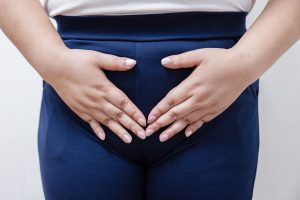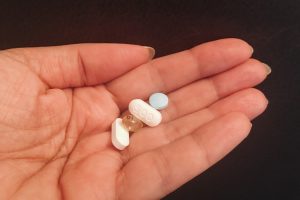A yeast infection — clinically known as candidiasis — is a common condition that can result in significant discomfort and inconvenience. It can cause infections in various body parts, each requiring unique treatment. Yeast infections typically occur in warm, moist areas of the body. This means regions like the mouth, underarms, and genitals. However, in severe cases, yeast infections can manifest in the digestive tract — the throat (oral thrush) or gut — and even within the bloodstream. In such extreme cases, seeking immediate professional medical help is crucial. Read more below to learn how to get rid of a yeast infection fast.
How To Get Rid of a Yeast Infection Fast
Depending on their severity and location, there are several ways to treat yeast infections. Over-the-counter antifungal creams, ointments, tablets, and suppositories are typically the first line of treatment for minor vaginal yeast infections, especially those in the genital area.
An antifungal medication can usually clear a yeast infection in three to seven days. These can be purchased at most pharmacies and are applied directly to where the infection is.
A doctor may prescribe an antifungal mouthwash for oral yeast infections or thrush. Meanwhile, for more severe or invasive yeast infections — including those that have spread to the bloodstream — stronger prescription antifungal medications given through intravenous or IV treatment may be required.
Is a Yeast Infection an STD/STI?
Although yeast infections can be transmitted through sexual activity — particularly vaginal yeast infections — it is not classified as an STI because they can also occur in individuals who are not sexually active.
However, it’s important to note that while yeast infections are not categorized as STDs or STIs, sexual intercourse can disrupt the balance of bacteria in the vagina and lead to a yeast overgrowth infection.
What Causes Yeast Infections?
Yeast infections are a common condition primarily caused by a multiplication of a fungus called Candida, specifically Candida albicans. Candida albicans is naturally present in our bodies, but when the balance of microorganisms is disrupted, it can proliferate, leading to uncontrollable growth and a yeast infection.
Reasons Why You May Develop a Yeast Infection
Several factors can contribute to the uncontrolled growth of the Candida fungus and its imbalance, causing individuals to develop a yeast infection. These include the following:
Antibiotics: Overusing antibiotics can disrupt the natural balance of bacteria in the body, enabling yeast to overgrow and cause an infection.
Pregnancy: Hormonal changes during pregnancy can heighten the risk of developing a yeast infection.
Diabetes: Uncontrolled diabetes can lead to elevated blood sugar levels, providing a conducive environment for yeast growth.
Weakened immune system: A weakened immune system — from diseases like HIV or certain medications — can make you more susceptible to yeast infections.
Uncontrolled HIV infection: People with uncontrolled HIV are more likely to develop recurrent candidiasis.
Damaged or irritated skin can also contribute to yeast infections. In such cases, the broken skin barrier allows an easy pathway for Candida or other yeasts to penetrate deeper tissues and multiply, causing an infection.
It is also worth noting that lifestyle factors like wearing tight, non-breathable clothing or underwear can create a warm, moist environment, which is ideal for yeast to thrive.
What Are the Symptoms of a Yeast Infection?
Common yeast infection symptoms can vary widely, often including discomfort and changes in the affected area. Typically, individuals may experience itching, burning, or soreness in the infected area, like bacterial vaginosis. For genital or vaginal candidiasis, it is possible to experience discharge that is white, clumpy, and odorless.
It is important to note that these symptoms can mimic other conditions. As such, it is crucial to get a professional diagnosis to ensure proper treatment.
Yeast Infection Symptoms in Women
In women, yeast infections most commonly affect the vagina. Vaginal candidiasis is a widespread health issue among women, with almost 1.4 million Americans seeking treatment per year.
The symptoms of a vaginal yeast overgrowth infection may include:
- Vaginal itching and irritation
- Vaginal rash
- Pain and soreness in general
- Discomfort or a burning sensation when urinating or having sex
- Redness and swelling of the vulva
- Thick, white vaginal discharge, similar to how cottage cheese looks
- Watery vaginal discharge
Yeast Infection Symptoms in Men
Yeast infections can also affect men, although they are usually less common. In men, candidiasis can cause:
- Redness, itching, or a rash on the penis and groin area
- Sores or blisters on the penis
- Burning sensation during urination or intercourse
- Thick, white, clumpy discharge, similar to how cottage cheese looks
- Foul-smelling discharge
- Difficulty pulling back the foreskin
Can a Yeast Infection Go Away in One Day?
Yeast infections are typically not resolved in one day. The duration of a yeast overgrowth infection can vary depending on its severity and the effectiveness of the treatment.
Even for mild cases of yeast infection, the fastest it can go away is usually around three to seven days. Some infections may require multiple courses of treatment or more potent prescription medications, leading to more extended recovery periods.
How Long Will a Yeast Overgrowth Infection Last Without Treatment?
Without proper treatment, a yeast infection may persist for an indefinite period. However, the duration can vary widely based on individual physiology and the strain of yeast causing the infection. It is typical for untreated yeast infections to last several days, weeks, or even months.
During this time, symptoms potentially worsen, causing increased discomfort and irritation. It is recommended to seek treatment for a yeast infection to alleviate symptoms and prevent the infection from worsening or recurring.
Remedies and Treatments for Yeast Infections
Several remedies and treatments are available to combat yeast infections, ranging from over-the-counter options to prescription-based solutions and even home remedies.
The most effective treatment for yeast overgrowth infections is a dedicated course of antifungal medication. These treatments range from topical creams to oral medications or mouthwash to suppositories. These aim to eliminate yeast overgrowth, alleviate symptoms, and prevent recurrences.
Read also: Can A Man Give A Woman A Yeast Infection?
One-Pill Yeast Infection Remedies
One-pill candidiasis treatments — such as fluconazole — are available over the counter and by prescription. These medications are taken orally and work by killing the yeast causing the infection. They are generally effective in treating yeast infections, but some women may require additional treatment or a more potent prescription medication.
How To Get Rid of a Yeast Infection Fast: Self-care Tips
In addition to medication, there are several self-care measures you can take to help manage candidiasis:
Keep the affected site clean and dry: Moisture can promote yeast growth, so it is vital to keep the affected site clean and dry.
Avoid irritants: Avoid using products that may irritate the affected area, such as scented soaps, bubble baths, and feminine hygiene sprays.
Wear loose-fitting clothing: Tight-fitting clothing can trap moisture and promote yeast growth, so opt for loose-fitting, breathable clothing and cotton underwear.
Avoid douching: This can distort the natural balance of bacteria in the vagina and heighten the risk of developing a yeast infection.

Over-the-Counter Candidiasis Treatments
Over-the-counter treatments for yeast overgrowth infections include antifungal creams, ointments, and suppositories. These products are available without a prescription and can help relieve symptoms and treat the infection.
However, if your symptoms remain or worsen after using an over-the-counter treatment, it is recommended that you see a doctor for further evaluation and treatment.
Prescription for Yeast Infection Treatments
If over-the-counter treatments do not alleviate your symptoms, your doctor may prescribe a more potent antifungal medication. These medications are generally more powerful and may be taken orally or applied as a cream, depending on the location of the infection.
Home Remedies for Yeast Infection
Home remedies can be a potent solution for treating mild yeast infections. While the effectiveness of home remedies can vary, some people may find relief from these natural, readily available options.
These options often consist of everyday household items or health products, making them popular for those seeking immediate, cost-effective treatment. It is important to note that home remedies should not be used as a substitute for medical treatment.
Below are eight popular home remedies often utilized to alleviate the symptoms of candidiasis.
1. Over-the-Counter Treatments
Some over-the-counter treatments may help manage yeast infections. However, these should be used with caution and under the guidance of a healthcare professional.
2. Boric Acid
Vaginal suppositories containing boric acid may help treat vaginal yeast infections. However, boric acid can be toxic if misused, so it is crucial to follow the directions painstakingly and consult a medical professional before use for good vaginal health. Pregnant women and women on birth control are advised to avoid this home remedy altogether.
3. Tea Tree Oil
Some research suggests that a combination of probiotics and suppositories that contain tea-tree properties may help treat vaginal candidiasis. Note that tea tree oil can irritate the skin and cause burning or discomfort. It is also toxic if ingested, so caution should be exercised with this home remedy.
4. Probiotic Supplements
Probiotics — like those found in natural yogurt or supplement form — may help regulate the balance of bacteria in the body and prevent yeast overgrowth. However, not all probiotics are created equal, so it is crucial to consult a medical expert before taking them.
5. Natural Yogurt
Some women find relief from candidiasis symptoms by applying natural, unsweetened yogurt to the affected area. The live cultures in the yogurt are thought to help reestablish the proper balance of bacteria in the body. However, more research is needed to confirm its effectiveness.
6. Coconut Oil
When applied topically to the affected area, this oil has natural antifungal properties and may help alleviate yeast overgrowth symptoms. Apply to the affected site and leave it on for several hours before rinsing off. Ensure you use pure, organic coconut oil and consult a healthcare professional before using it.
7. Garlic
Garlic is often touted as a home remedy for yeast infections due to its antifungal properties. It is commonly recommended to insert a clove of garlic into the vagina for one to two hours to treat vaginal candidiasis. While some find this method helpful, limited scientific evidence supports its effectiveness, and it may cause discomfort or additional complications.
8. Oil of Oregano
The wild oregano variant has potent antifungal properties, making it highly reliable in treating candidiasis. Mix some drops of oil of wild oregano (Origanum vulgare) with a carrier oil and apply to the affected site. Always conduct a patch test before completing an application and consult your healthcare professional for advice.
When To Avoid Home Remedies
When infection symptoms persist, worsen, or recur despite home remedies, it is imperative to seek professional medical advice, as these could signal a more serious underlying condition or incorrectly diagnosed candidiasis.
Moreover, it is essential to avoid home remedies if you are pregnant or have a weakened immune system. In particular, trying boric acid as a home remedy while pregnant can endanger the fetus.
How Can I Prevent Future Yeast Infections?
To prevent recurrent candidiasis, consider making dietary changes that include consuming probiotics, which help maintain the balance of bacteria in your body. Women are advised to avoid using scented pads or tampons, as well as the use of feminine area deodorants to prevent vaginal yeast infections in particular.
Lastly, maintaining a healthy immune system through regular exercise and adequate sleep can decrease the likelihood of recurrent yeast infections.
Yeast Infection Prevention Tips
Preventing yeast infections can be challenging, but you can take plenty of steps to reduce your risk.
Practice good hygiene: Keep the affected site clean and dry, and avoid using products that may irritate the skin.
Wear breathable clothing: Opt for loose-fitting, breathable clothing to prevent moisture buildup.
Limit antibiotic use: Antibiotics can disrupt the natural balance of bacteria in the body, so using them only when necessary is essential.
Manage diabetes: If you have diabetes, controlling your blood sugar levels is vital to prevent candidiasis.
What Happens if a Yeast Infection Is Left Untreated?
If a yeast infection is left untreated, several complications may arise, including the following issues:
- Sores developing in the affected area
- Headaches
- Fatigue
- Other infections
- Infertility
How Do I Know if It’s a Yeast Infection or an Urinary Tract Infection (UTI)?
The symptoms of yeast infections and UTIs can be similar, but some key differences exist. Yeast infections typically cause itching and irritation in the vaginal area, as well as a thick, white discharge and pain during sex or urination.
UTIs — on the other hand — cause pain or burning sensation when urinating, as well as frequent urination and cloudy or strong-smelling urine. It is best to see a healthcare professional for an accurate diagnosis if you are unsure whether you have a yeast infection or a UTI.
When To See a Doctor
It is essential to consult a medical if your yeast infection symptoms persist despite applying home remedies. The same applies if your symptoms are severe, even if you have yet to try home remedies.
Medical advice is crucial if you’re experiencing severe discomfort or the infection recurs within two months. Additionally, individuals never diagnosed with candidiasis should immediately seek medical attention to confirm the diagnosis and avoid potential complications.
Read next: A Guide to Using Natural Remedies for Yeast Infection
Frequently Asked Questions
While home remedies cannot replace professional medical advice, some methods may alleviate yeast infection symptoms. These include applying natural yogurt or essential oil to the affected area, taking probiotics, and avoiding irritants such as scented products and tight-fitting clothing. Over-the-counter antifungal creams also provide relief.
However, it is essential to consult a women’s health professional before trying new treatment options.
Maintaining good personal hygiene, wearing breathable underwear, and avoiding douches can help prevent yeast infections. For treatment, consider natural remedies like diluted tea tree oil or essential oil of oregano.
Remedies like borax acid or coconut oil relieve recurrent yeast infections with discharge. You may also consider dietary changes to promote healthy gut flora, like reducing sugar intake. However, recurrent infections may indicate an underlying health issue, so it is more advisable to seek professional medical advice.
Popular DIY methods to treat vaginal candidiasis include applying diluted tea tree oil, apple cider vinegar, and essential oil of oregano directly to the affected area. Plain Greek yogurt — either eaten or applied to the vaginal area — is also a standard DIY treatment. Eating a balanced diet rich in probiotics and supplements may also help. Hydrogen peroxide may lessen the effects of the infection symptoms.
Consider antifungal medication targeting yeast specifically for persistent yeast infections despite antibiotic usage. Complement your treatment with probiotic-rich foods to restore healthy flora balance. Consult your healthcare provider to rule out underlying conditions and tailor an effective treatment plan.
While mild yeast infections may respond to home remedies like yogurt-based creams or probiotic-rich diets, it’s vital to consult a healthcare professional for a proper diagnosis and treatment plan. Remember that self-care should complement — not replace — professional medical care, particularly for persistent or recurrent candidiasis.
Drinking plenty of water can help flush out toxins, including yeast, from your body. Unsweetened cranberry juice is also beneficial due to its antifungal properties. Additionally, herbal teas — particularly those containing peppermint or ginger — may support immune function to fight off infection.
Complete elimination of candidiasis can take longer than 24 hours. The quickest way to alleviate symptoms is through a prescribed antifungal medication. However, this can still take a minimum of three days. The prescription pill fluconazole or Diflucan is shown to be a quick and effective treatment.





